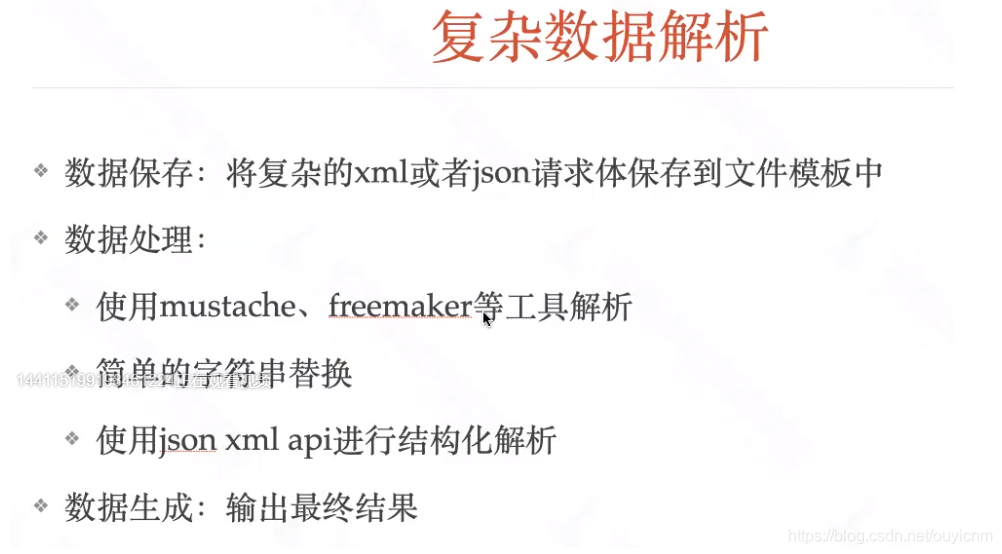一.requests介绍
-
requests模块是python的第三方库,使用它我们可以非常方便的发起get,post等接口请求。并且获取接口的返回值。在自动化中我们常常使用requests模块来编写接口自动化测试用例。
-
requests的官方文档为:https://docs.python-requests.org/zh_CN/latest/
二.requests详解
1.安装
pip install requests
2.常用API
2.1发送请求相关的API
(1) 发送get请求API
requests.get('https://github.com/ouyi-github/') # 不带参数
requests.get(url='http://dict.baidu.com/s', params={'wd':'python','from':'zici'}) # 带参数。方式1
requests.get(url='https://dict.baidu.com/s?wd=python&from=zici') # 带参数。方式2
(2)发送post请求API
r = requests.post('http://httpbin.org/post', data = {'key':'value'}) #以form表单形式提交数据
r = requests.post('https://api.github.com/some/endpoint', data=json.dumps({'some': 'data'})) # 以json形式提交数据,方式1
r = requests.post('https://api.github.com/some/endpoint', json={'some': 'data'}) # 以json形式提交数据,方式2
# xml格式提交数据
heards = {'Content-type': 'text/xml'}
XML = '<?xml version="1.0" encoding="utf-8"?><soap:Envelope xmlns:xsi="http://www.w3.org/2001/XMLSchema-instance" xmlns:xsd="http://www.w3.org/2001/XMLSchema" xmlns:soap="http://schemas.xmlsoap.org/soap/envelope/"><soap:Body><Request xmlns="http://tempuri.org/"><jme><JobClassFullName>WeChatJSTicket.JobWS.Job.JobRefreshTicket,WeChatJSTicket.JobWS</JobClassFullName><Action>RUN</Action><Param>1</Param><HostIP>127.0.0.1</HostIP><JobInfo>1</JobInfo><NeedParallel>false</NeedParallel></jme></Request></soap:Body></soap:Envelope>'
url = 'http://jobws.push.mobile.xxxxxxxx.com/RefreshWeiXInTokenJob/RefreshService.asmx'
r = requests.post(url=url, heards=heards, data=XML)
(3)发送其他请求API
r = requests.put('http://httpbin.org/put', data = {'key':'value'})
r = requests.delete('http://httpbin.org/delete')
r = requests.head('http://httpbin.org/get')
r = requests.options('http://httpbin.org/get')
2.2 获取响应相关的API
r.encoding #获取当前的编码
r.encoding = 'utf-8' #设置编码
r.text #以encoding解析返回内容。字符串方式的响应体,会自动根据响应头部的字符编码进行解码。
r.content #以字节形式(二进制)返回。字节方式的响应体,会自动为你解码 gzip 和 deflate 压缩。
r.headers #以字典对象存储服务器响应头,但是这个字典比较特殊,字典键不区分大小写,若键不存在则返回None
r.status_code #响应状态码
r.raw #返回原始响应体,也就是 urllib 的 response 对象,使用 r.raw.read()
r.ok # 查看r.ok的布尔值便可以知道是否登陆成功
#*特殊方法*#
r.json() #Requests中内置的JSON解码器,以json形式返回,前提返回的内容确保是json格式的,不然解析出错会抛异常
r.raise_for_status() #失败请求(非200响应)抛出异常
r.cookies # 响应中的cookies
2.3 文件上传API
url = 'http://127.0.0.1:8080/upload'
files = {'file': open('/home/rxf/test.jpg', 'rb')}
r = requests.post(url, files=files)
2.4 请求中添加头部信息
data = {'some': 'data'}
headers = {'content-type': 'application/json',
'User-Agent': 'Mozilla/5.0 (X11; Ubuntu; Linux x86_64; rv:22.0) Gecko/20100101 Firefox/22.0'}
r = requests.post('https://api.github.com/some/endpoint', data=data, headers=headers)
2.5 请求中添加cookie信息
data = {'some': 'data'}
cookie = {'key':'value'}
r = requests.post('https://api.github.com/some/endpoint',data=data,cookies=cookie)
2.6 复杂数据添加到请求中


实战:企业微信添加成员API
第一步:分析企业微信接口文档
https://work.weixin.qq.com/api/doc/90000/90135/90195
第二步:将请求数据写入json文件
{
"userid": "{{userid}}",
"name": "{{name}}",
"department": [1, 2],
"mobile": "{{phone}}"
}
第三步;在代码中修改json文件内容,并作为请求的数据发送
import requests
import pystache
class TestDemo:
def test_demo(self):
with open('data/add_remenber.json','r',encoding='utf-8') as f:
contect = f.read()
rewrite = {
'userid':'ojbkdsb1',
'name':'ojbkdsbsd2',
'phone':'13118175697'
}
re_contect = pystache.render(contect,rewrite) # 替换内容中的变量,contect为代替换的内容(需要为str),rewrite为替换规则
print(re_contect)
url = 'https://qyapi.weixin.qq.com/cgi-bin/user/create?access_token=3pFM-B9TUPfVp1LXzADf91gnk1Nuxlr92AlyZg0QYWF0G8VnXS5OIUOykSLBhAswELF_' \
'IcKkZ2cWlRtaXObX0fh6KpWv4-MgdAxtZJ' \
'j19zqxnWlHgWQfXeB9i3zPRgVt3Ohb1WPR9kRj72O1QXy9L1z1azQGmE_2RnIIqDcChIKEorbpSWj_ez0iHchE-9dkzIHsDZoMtNDekY3RVvCkyw&debug=1'
r = requests.post(url,data=re_contect)
print(r.json())
这样我们可以将复杂的请求数据存放在文件中,在使用代码修改数据内容后使用。
2.7 使用响应中的复杂内容断言
在做接口自动化测试时,有时我们需要使用响应的json或者xml数据作为断言。而有些数据嵌套特别深,这时我们如果从第一层往里取这个数据,会使得表达式特别长。
这时我们可以使用json path来获取json中的数据
(1)json path
安装:
pip install jsonpath
from jsonpath import jsonpath
jsonpath(json_content,'$.store.book[0].price') # 两个参数:json_content就是json内容,'$.store.book[0].price'是jsonpath表达式
JsonPath中的“根成员对象”始终称为$,无论是对象还是数组。
JsonPath表达式可以使用点表示法
$.store.book [0].title
或括号表示法
$['store']['book'][0]['title']
| 操作 | 说明 |
|---|---|
| $ | 查询根元素。这将启动所有路径表达式。 |
| @ | 当前节点由过滤谓词处理。 |
| * | 通配符,必要时可用任何地方的名称或数字。 |
| … | 深层扫描。 必要时在任何地方可以使用名称。 |
| . | 点,表示子节点 |
| [’’ (, ‘’)] | 括号表示子项 |
| [ (, )] | 数组索引或索引 |
| [start:end] | 数组切片操作 |
| [?()] | 过滤表达式。 表达式必须求值为一个布尔值。 |
函数可以在路径的尾部调用,函数的输出是路径表达式的输出,该函数的输出是由函数本身所决定的。
| 函数 | 描述 | 输出 |
|---|---|---|
min() | 提供数字数组的最小值 | Double |
max() | 提供数字数组的最大值 | Double |
avg() | 提供数字数组的平均值 | Double |
stddev() | 提供数字数组的标准偏差值 | Double |
length() | 提供数组的长度 | Integer |
过滤器是用于筛选数组的逻辑表达式。一个典型的过滤器将是[?(@.age > 18)],其中@表示正在处理的当前项目。 可以使用逻辑运算符&&和||创建更复杂的过滤器。 字符串文字必须用单引号或双引号括起来([?(@.color == ‘blue’)] 或者 [?(@.color == “blue”)]).
| 操作符 | 描述 |
|---|---|
== | left等于right(注意1不等于’1’) |
!= | 不等于 |
< | 小于 |
<= | 小于等于 |
> | 大于 |
>= | 大于等于 |
=~ | 匹配正则表达式[?(@.name =~ /foo.*?/i)] |
in | 左边存在于右边 [?(@.size in [‘S’, ‘M’])] |
nin | 左边不存在于右边 |
size | (数组或字符串)长度 |
empty | (数组或字符串)为空 |
实例:
{
"store": {
"book": [
{
"category": "reference",
"author": "Nigel Rees",
"title": "Sayings of the Century",
"price": 8.95
},
{
"category": "fiction",
"author": "Evelyn Waugh",
"title": "Sword of Honour",
"price": 12.99
},
{
"category": "fiction",
"author": "Herman Melville",
"title": "Moby Dick",
"isbn": "0-553-21311-3",
"price": 8.99
},
{
"category": "fiction",
"author": "J. R. R. Tolkien",
"title": "The Lord of the Rings",
"isbn": "0-395-19395-8",
"price": 22.99
}
],
"bicycle": {
"color": "red",
"price": 19.95
}
},
"expensive": 10
}
[$.store.book[*].author] | 获取json中store下book下的所有author值 |
|---|---|
[$..author] | 获取所有json中所有author的值 |
[$.store.*] | store下的所有的东西 |
[$.store..price] | 获取json中store下所有price的值 |
[$..book[2]] | 获取json中book数组的第3个值 |
[$..book[-2]] | 倒数的第二本书 |
[$..book[0,1]] | 前两本书 |
[$..book[:2]] | 从索引0(包括)到索引2(排除)的所有图书 |
[$..book[1:2]] | 从索引1(包括)到索引2(排除)的所有图书 |
[$..book[-2:]] | 获取json中book数组的最后两个值 |
[$..book[2:]] | 获取json中book数组的第3个到最后一个的区间值 |
[$..book[?(@.isbn)]] | 获取json中book数组中包含isbn的所有值 |
[$.store.book[?(@.price < 10)]] | 获取json中book数组中price<10的所有值 |
| [`$…book[?(@.price <= $[‘expensive’])] | 获取json中book数组中price<=expensive的所有值 |
[$..book[?(@.author =~ /.*REES/i)]] | 获取json中book数组中的作者以REES结尾的所有值(REES不区分大小写) |
[$..*] | 逐层列出json中的所有值,层级由外到内 |
[$..book.length()] | 获取json中book数组的长度 |
2.8 jsonschema断言
(1)什么是jsonschema
JSON Schema是基于JSON格式,用于定义JSON数据结构以及校验JSON数据内容。
(2)为什么需要jsonschema断言
在实际开发过程中,接口返回的json数据十分庞大,如果我们需要对每一个数据都做断言,会导致断言代码量过大,且不灵活。
使用JSON Schema可以自动判断json数据类型是否符合我们预期
(3)使用jsonschema
第一步:编写jsonschema文件,来定义json数据类型格式// filename = my_schema.json
{
"$schema": "http://json-schema.org/draft-04/schema#",
"title": "TestInfo",
"description": "some information about test",
"type": "object",
"properties": {
"name": {
"description": "Name of the test",
"type": "string"
},
"age": {
"description": "age of test",
"type": "integer"
}
},
"required": [
"name", "age"
]
}
jsonschema关键字的含义和作用
| 关键字 | 描述 |
|---|---|
| $schema | 表示该JSON Schema文件遵循的规范 |
| title | 为该JSON Schema文件提供一个标题 |
| description | 外层表示关于该JSON Schema文件的描述信息,内层表示关于该JSON数据的描述信息 |
| type | 表示待校验元素的类型(例如,最外层的type为object表示待校验的是一个JSON对象,内层type分别表示待校验的元素类型为,整数,字符串,数字) |
| properties | 定义待校验的JSON对象中,各个key-value对中value的限制条件 |
| required | 定义待校验的JSON对象中,必须存在的key |
| minimum | 用于约束取值范围,表示取值范围应该大于或等于minimum |
| exclusiveMinimum | 如果minimum和exclusiveMinimum同时存在,且exclusiveMinimum的值为true,则表示取值范围只能大于minimum |
| maximum | 用于约束取值范围,表示取值范围应该小于或等于maximum |
| exclusiveMaximum | 如果maximum和exclusiveMaximum同时存在,且exclusiveMaximum的值为true,则表示取值范围只能小于maximum |
| multipleOf | 用于约束取值,表示取值必须能够被multipleOf所指定的值整除 |
| maxLength | 字符串类型数据的最大长度 |
| minLength | 字符串类型数据的最小长度 |
| pattern | 使用正则表达式约束字符串类型数据 |
type常见的取值
| type取值 | 对应的python数据类型 |
|---|---|
| object | Object |
| array | List |
| integer | int |
| number | float或int |
| null | None |
| boolean | .Boolean |
| string | String |
import json
from jsonschema import validate
class TestDemo:
def test_demo(self):
# json内容
json_content = {
"name": "python",
"age": 25
}
# schema文件
with open('data/my_schema.json','r',encoding='utf-8') as f:
my_schema = json.load(f)
# 校验
validate(instance=json_content,schema=my_schema) # 参数instance表示待校验的json数据,schema表示schema规则
2.9 请求中添加认证信息
一些http请求需要在请求数据中添加认证信息,才能正确响应。 
那么如何在requests中添加认证信息呢??

2.10 requests请求发送图片
以企业微信上传图片为例:
class MaterialPage(BasePage):
"""素材管理page类"""
def up_image(self,filename):
"""
上传图片
:return:
"""
filedir = os.path.join(IMAGESDIR,filename)
with open(file=filedir,mode='rb') as f:
file = {"file": f}
r = self.requests.post("https://qyapi.weixin.qq.com/cgi-bin/media/upload?type=image",files=file)
return r
第一步:将图片读取为二进制文件
第二步:将读取的二进制文件,存进字典中,key为“file”
第三步:将字典传递到参数files中,发送请求
